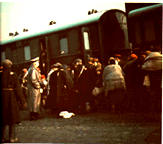 Deportation of Jewish People from the Lodz Ghetto
Deportation of Jewish People from the Lodz Ghetto
The Nazi Genocide of the Jews, 1933-45: A Brief Introduction to the
Holocaust
Robert S. Leventhal
Copyright (c) 1995 by Robert S. Leventhal, all rights reserved. This text
may be shared in accordance with the fair-use provisions of the U.S. Copyright
Law. Redistribution or republication of this text on other terms, in any
medium, requires the written permission of the author.
"The murder of the European Jews in the Second World War
was unique. Never before did a state decide to kill a specific group of
humans -- including old people, women, and children -- without any
reservation or examination of the individual case, and enact this murder
with the means of State power."
-- Eberhard Jäckel, German Historian and Director of the Institute for
Contemporary History, University of Stuttgart
This hypertext document is intended to introduce the reader/viewer to the
historical event of the Nazi Genocide of the Jewish People of Europe,
1933-1945. In these years, approximately six million Jewish men, women and children were systematically murdered in extermination or "death" camps located in Eastern Europe. Genocide refers to the mass murder
of a tribe or an entire people (genos=tribe, people; cide=killing). According
to Yehuda Bauer, one of the most prominent historians of the Nazi
Genocide of the Jews, the term was first coined in 1943 by Raphael Lemkin,
who defined it as "a synchronized attack" on the moral, political, cultural,
religious, economic and social aspects of a people's life, involving a "policy of depopulation,
introducing a starvation rationing system" and carrying out systematic "mass
killings."[1] After World War II, the United Nations
convened hearings and formulated a legal definition of Genocide as an
international crime in times of war and peace. This was called the
Convention on Genocide of 1948,
which was influenced and informed by the Nazi Genocide of the Jews.[2]
The Nazi Genocide of the Jewish Population of Europe is usually divided into
phases. Click on any of the text in blue type to move to more information concerning
a specific phase:
Photo: Alex Grobman and Daniel Landes, eds., Genocide: Critical Issues
of the Holocaust (Los Angeles and Chappaqua,N.Y.: Simon Wiesenthal
Center, 1983).
Photo: Grobman & Landes, eds., Genocide.
Photo:Alan Adelson and Robert Lapides, eds., Lodz Ghetto (New York:
Penguin, 1989).
-
 Click here for Maps of the Holocaust
Click here for Maps of the Holocaust
 Click here to explore Auschwitz
Click here to explore Auschwitz
 Click here
to go to the article on Genocide
Click here
to go to the article on Genocide
Notes
Yehuda Bauer, The Holocaust in Historical Perspective
(Seattle: University of Washington Press, 1978), pp. 34-35.Back
The United Nations, For Fundamental Human Rights (Lake Success: United Nations, 1948).Back
Last Modified Jan. 20, 1995
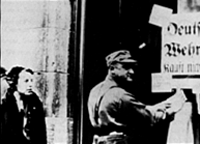 Hitler's Rise to Power 1933 and the "Nazification" or
Gleichschaltung of German Society: Persecution, Arrests, Boycotting, and Picketing
Hitler's Rise to Power 1933 and the "Nazification" or
Gleichschaltung of German Society: Persecution, Arrests, Boycotting, and Picketing The Legalization of Nazi Policy: The Nuremberg Laws (1935)
The Legalization of Nazi Policy: The Nuremberg Laws (1935)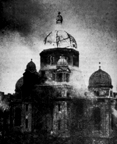 The Night of Broken Glass (Kristallnacht) 1938
The Night of Broken Glass (Kristallnacht) 1938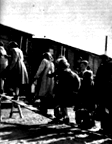 Internment and Concentration of the Jews of Europe, 1939-41
Internment and Concentration of the Jews of Europe, 1939-41 Deportation of Jewish People from the Lodz Ghetto
Deportation of Jewish People from the Lodz Ghetto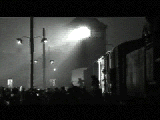 The "Final Solution of the Jewish Problem," 1941-45
The "Final Solution of the Jewish Problem," 1941-45 Click here for Maps of the Holocaust
Click here for Maps of the Holocaust Click here to explore Auschwitz
Click here to explore Auschwitz